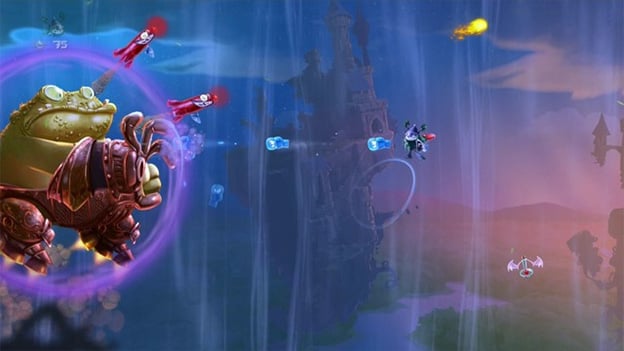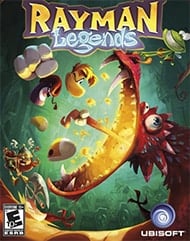I Don’t Know What I Just Played, but I Know I Liked It
Confidence exudes from Rayman Legends . The game juggles a staggering amount of absurd content. A flaming eyeball, a hero without any limbs, and a frog-like fly named Murfy all exist in the same level. Only the certainty of craftsmanship holds the game together, a certainty that provides the keystone upon which the rest of the chaos is built. Rayman Legends deconstructs the platforming formula down to its simplest, most joyful form, and most everyone will enjoy playing it.
The narrative takes little time to set up the game’s sparse stage. Murfy awakens Rayman and Globox from a century-long nap to help purge the Nightmares that threaten to overtake the game’s world, The Glade of Dreams. As soon as Rayman takes his first step, the game begins, taking players through a quick tutorial level that acquaints them with the simple controls.
Four buttons control Rayman and his pals. There’s a sprint button, an attack button, a jump button, and a Murfy button. Holding down the attack button unleashes a more powerful attack with extended reach, and tapping the jump button while in mid-air causes a character to strain for a few extra inches before hitting the ground. The Murfy button, unsurprisingly used to control the eternally helpful Murfy, informs the fly as to when he should interact with objects. The simple way the controls manipulate the characters keeps the anarchy of the game from becoming too tough to contain.
Murfy follows your character around during certain levels, and he interacts with a lot of objects in the most surprising ways possible. In one level, pressing the Murfy button gives Murfy the go ahead to eat the self-regenerating cake obstructing your path. In another level, pressing the button compels him to slather the stage with guacamole solid enough to stand on: a sauce that will, at essential points in the map, keep hot lava from falling on the hero’s head. And then, in a different level, Murfy will help control laser-shooting drones with spotlights attached to them. When I said this game is absurd, I meant that it abandoned all notions of sanity and reason.

But, I suppose, for a game that takes place in something called The Glade of Dreams, abandoning all sanity might not be such a bad thing. The unrestrained creativity of the developers produced some astounding stages. Each level offers a unique setting and each is detailed in sharp, gorgeous art. Never has so much work gone into making a creature with four eye-infused hand-tentacles so appealing. The levels of Rayman Legends are themed, and a large part of the appeal of the stages comes from the commitment the developers display in sticking to those themes.
For instance, the stages inside the “Fiesta de los Muertos” area of the game contain skulls with brains exposed, colorful, top-hat-wearing skeletons (some of which play instruments), a variety of food-based obstacles to traverse, and a giant, masked wrestler. This is only one example, as each of the six standard areas in the game show-off a plethora of unconventional monsters and platforms that all fit within a single theme. My favorite themed obstacle is the hand of Zeus, which descends in a Greek myth-based stage to plague the player with a stream of lightning. These monstrous additions add just one more appealing part to the most chaotic platformer formula this side of indie.

And these levels don’t have to be experienced alone. Up to four players can play on the same screen (five on the Wii U using the GamePad). Each added player cranks up the danger factor, as each player-character can interact with other player-characters. If playing on the Wii U, the fifth person will control Murfy by using the GamePad, and when Murfy isn’t available, that player will manipulate the environment. GamePad-Murfy functions differently than the other, auto-button versions and adds a much more in-depth and engaging gameplay element. The enjoyment factor of the game, while high alone, multiplies with each additional person playing.
As Rayman and his colleagues traverse the levels, they acquire quite the odd assortment of goodies and collectibles. Lums and Teensies mark the most common treasures beneath the metaphorical Xs. Both of these collectibles act as checkpoints: Collecting enough Lums unlocks different playable characters, freeing enough Teensies unlocks levels. The way levels unlock, however, opens up the game in a very welcome way. Although each area has a beginning stage and an end stage, the in-between levels can be played in many different orders and players can hop from one area to another without finishing either. This type of freewheeling level-select system fits nicely with the “let’s just have fun” attitude of the game.
That attitude of wanting to deliver pure enjoyment carries over into the extra areas of Rayman Legends . Oddly, the game sports a soccer mini-game, where players can kick a very lightweight soccer ball back and forth across the screen in an effort to score points. A monster room also lies nestled in the optional areas of the game. Players can collect monsters by scratching off lottery tickets. These lottery tickets automatically pop in the player’s “inventory” after completing missions. Completing missions also rewards players an Awesomeness level. I couldn’t find any discernable measurement for gaining Awesomeness levels, but earning a level sure made me feel good. And, at its core, I’m pretty sure that’s what this game was designed to do.

The way Rayman Legends punishes mistakes reinforces the idea that it wants nothing more than to just be a good time. Random, frequent, and invisible checkpoints populate each stage. Players will oftentimes find themselves making a misstep as they zip through a level. When a character falls off a cliff or runs into an enemy, that character bloats up, pops like a balloon, and then reappears usually no more than one screen back. Rayman Legends uses no lives, enforces no failure penalty, and never forces a player to replay a nearly completed level. Although games like Mario have long since dispensed with the notion that extra lives actually matter, they continue the tradition of using them to maintain the pretense of consequence. Rayman Legends doesn’t do that, and it’s probably the game’s greatest asset.
Rayman Legends’ unique, quirky tune introduces new steps into an old dance. Although the absurd nature of the game might be a hurdle to some, Ubisoft crafted it with enough skill and confidence to tie together all the disparate strands into a cohesive, enjoyable whole. A lot of care went into making Rayman Legends , and the refreshing result of that care is a platformer that can proudly stand beside the genre’s greats.
RATING OUT OF 5 RATING DESCRIPTION 5.0 Graphics
The sharp, gorgeous, and vibrant art might not be for everyone, but it never seems out of place and is always a pleasure to look at. 4.5 Control
The simple controls do an awful lot. The occasional hiccup might make players stumble, but these are few and far between. 4.0 Music / Sound FX / Voice Acting
Fitting music accompanies each level, and the various sound effects only strengthen the score. 4.0 Play Value
Enough collectables populate the world to give anyone an excuse to return to the game. Ubisoft went the extra mile by including 40 levels from Rayman Origins . 4.5 Overall Rating – Must Buy
Not an average. See Rating legend below for a final score breakdown.
| Review Rating Legend | |||
|---|---|---|---|
| 0.1 – 1.9 = Avoid | 2.5 – 2.9 = Average | 3.5 – 3.9 = Good | 4.5 – 4.9 = Must Buy |
| 2.0 – 2.4 = Poor | 3.0 – 3.4 = Fair | 4.0 – 4.4 = Great | 5.0 = The Best |
Game Features:
